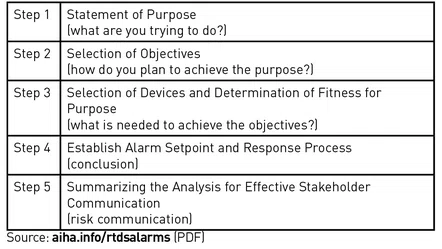

DEPARTMENTS

INSTRUMENTATION
SPENCER PIZZANI, CIH, is the occupational health manager for PepsiCo Global EHS.
EVISON CAREFOOT, CIH, PEng, CRSP, is senior consultant with Salus Services Limited.
ROBERT HENDERSON is past chair of the AIHA Real-Time Detection Systems Committee and president of GfG Instrumentation Inc.
STEVEN JAHN, CIH, MBA, FAIHA, is a technical advisor for Savannah River Nuclear Solutions LLC in Aiken, South Carolina, and president of Jahn Industrial Hygiene LLC.
Send feedback to The Synergist.
Practical Examples of Alarm-Setting Guidance, Part 1
BY SPENCER PIZZANI, EVISON CAREFOOT, ROBERT HENDERSON, AND STEVEN JAHN
Setting alarms for direct-reading instruments (DRI) can be the most complex part of implementing a real-time detection system (RTDS). Recent developments, such as changes to exposure limits, an emphasis on systematic review of the capabilities of DRI, advancements in sensor technology, and a reduction in cost for instrumentation, have prompted discussion in the occupational and environmental health and safety professional community regarding the determination of alarm setpoints or thresholds. Factors such as increased adoption of statistical analysis and changes in the social relationship between workers and employers have also contributed to discussion of the transparency of the alarm-setting process.
A new publication available from AIHA (PDF) provides practical guidance for setting alarms. This process includes five steps, which are summarized in Table 1, for determining the appropriate alarm settings based on a systematic analysis of signaling context. Each step is intended to functionally align multiple components, including RTDS fitness for purpose, systematic review of DRI, and stakeholder expectations, to result in a system configuration that meets the needs of the party designing and deploying the RTDS in a specific exposure context.
Table 1. Proposed Steps for Alarm-Setting Process

Click or tap on the table to open a larger version in your browser.
Key to this process is the fundamental principle that each alarm must trigger a defined response from a human, mechanical, or information system. The purpose of an alarm is to prompt action as defined by the scenario: any alarm that is not intended to result in an action only habituates workers to alarm conditions.
The publication also identifies four types of monitoring activities: Designation A for safety monitoring, which may encompass explosive hazards or running machinery, for example; Designation B for health monitoring, which may focus on exposure levels or specific chemicals such as benzene and carbon monoxide; Designation C for combined safety and health monitoring, such as exposure to both an explosive hazard and a chemical hazard; and Designation D for other kids of monitoring, such as process monitoring or research activities.
The AIHA RTDS Committee is pleased to partner with The Synergist to provide several practical examples of this guidance in action to reinforce practical application. This article presents the first example concerning carbon monoxide exposures to foundry crane operators. Additional scenarios are planned for future issues.
STEP 1: ESTABLISH STATEMENT OF PURPOSE
A ferrous foundry in British Columbia, Canada, identified TWA exposures to carbon monoxide (CO) above the regulatory 25 ppm time-weighted average OEL (but not above the regulatory 100 ppm short-term exposure limit) in several overhead cab-operated cranes. An engineering control allowing remote control of the cranes was selected; however, until these remote controls could be acquired, operator rotation was implemented to limit exposures to below the TWA-OEL. The purpose of alarms was to alert crane operators before their TWA exceeded the Threshold Limit Value, which was also 25 ppm, allowing for job rotation.
STEP 2: SELECT OBJECTIVES
The objective of monitoring was to provide operators with continuous exposure data throughout their shift and to establish alarms for notification of potential overexposure in time to initiate rotation. The risk of overexposure in this workplace setting would identify the intent of CO monitoring and alarm notification as Designation B (health monitoring). The objective of monitoring was to prompt employee-initiated rotation as a control.
STEP 3: SELECT DEVICES AND DETERMINE FITNESS FOR PURPOSE
Site personnel were familiar with and had access to a variety of CO monitors. Although numerous CO sensor and instrument configurations met the stated objectives in the range of exposures workers experienced, the single-gas CO monitors were selected for their simplicity and long battery life. Additionally, selecting an instrument already familiar to the employees helped reduce training needs and mitigate the potential for operational error.
STEP 4: ESTABLISH ALARM SETPOINTS AND RESPONSE PROCESS
Previous exposure monitoring data helped configure the low, high, TWA, and STEL alarms. The manufacturer’s default setpoints (35, 70, 35, and 400 ppm, respectively) were not appropriate because they did not align with Canadian provincial limits. With a focus on health monitoring, the TWA alarm was considered the primary alarm.
In British Columbia, the OEL for CO consists of an 8-hour TWA of 25 ppm and a 15-minute STEL of 100 ppm. The personal CO monitors that were evaluated offered plus-or-minus 1.0 ppm resolution over a wide measurement range that typically extended to 500 ppm or 1,000 ppm.
A review of exposure monitoring records indicated that it was possible for an operator’s TWA to increase from 20 ppm to 25 ppm in less than 20 minutes, so the alarm was set at a TWA of 17 ppm to allow enough time for operators to coordinate rotations without disrupting operations. Because historical data showed that the STEL (100 ppm) was rarely exceeded, this alarm was conservatively set at 75 ppm, again to allow coordination of job rotation.
The low and high instantaneous alarms were set to concentrations well below the IDLH level (immediately dangerous to life or health) but above the highest recorded reading (165 ppm) to reduce the likelihood that operators would confuse them with the TWA alarm that required them to initiate a rotation. The facility developed a specialized functional test to demonstrate the operability of alarms at these concentrations.
According to the “three by five rule,” which is outlined in the provincial requirements and in the ACGIH TLV handbook, instantaneous alarms should not be set higher than five times the TLV-TWA. But because regulations had established a STEL for CO, it was not mandatory to apply the three by five rule. Per this evaluation, the settings shown in Table 2 were specified.
Table 2. Final Alarm Settings
The operator alarm notifications were supplemented by a requirement for operators on each shift to observe and record their assigned instrument’s TWA reading at their mid-shift break. This requirement was intended to reinforce operators’ awareness of their TWA so they could rotate, if needed, prior to an alarm sounding during a time when rotation could not be immediately executed.
STEP 5: SUMMARIZE THE ANALYSIS FOR EFFECTIVE STAKEHOLDER COMMUNICATION
The logic and process for overhead cab crane operators’ job rotation due to CO exposures was documented in the existing safe work instruction as well as by an exposure control plan required by regulation. All operators were trained on the safe work instruction, job rotation process, instrument operation (with emphasis on never turning off their assigned monitor during a shift, which would reset the TWA calculation), and data recording obligations. This administrative control program was successfully implemented until cranes were retrofit with remote controls.
RESOURCES
ACGIH: “TLV Chemical Substances Introduction.”
AIHA: “Establishing a Process for the Setting of Real-Time Detection System Alarms” (PDF).
The Synergist: “Cause for Alarm” (March 2023).